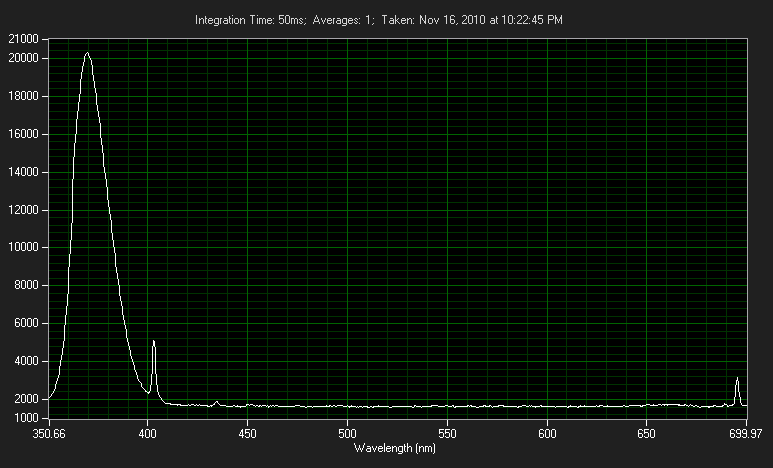One problem with looking at UV is that it's hard to tell why it looks so desaturated. The most obvious cause is a noisy signal. Here at LPF a number of people have posted the spectrometer readings of various laser pointers. They tend to look like tall narrow bell curves with very long, dirty tails. As we learn in statistics, not everything that looks like a bell curve is a true normal curve or Gaussian distribution. The same is true for the sensitivity curves of the rods and cones: in the real world they too have very long, dirty tails. Only in published editions do we see how the graphic designers cleaned them up to make the curves look more Gaussian.
The second complicating factor is eye fluorescence combined with UV opacity, which makes it hard to estimate what we are actually seeing. Last night I was shining various uv lights into my own eyes while looking in a mirror. The lens is quite a bit deeper in the eye than I realized (and changes shape as I change my focus). It doesn't take much to make it fluoresce. Nevertheless, I can see through the fluorescence and see the same eye staring back at me in the mirror.
Yesterday I was reading about this online, including how much UV the lens filters out. At birth it hardly filter out any, but by the time we become adults it's already an OD3 - OD4 filter for anything below 400nm, exact wavelength rising with age. Many elderly persons have trouble seeing violet or even blue. On the other hand, human vision spans a brightness range of ten orders of magnitude, seven for photopic (color) vision, so even OD4 should not be an absolute barrier.
Finally, I've stumbled only some researchers in the field of human UV vision who have discovered that humans possess an opsin known as rhodonine 11 or r(11). The molecule itself has a peak sensitivity at 342nm although in the human eye the peak seems to be something like 353nm. r(11) is apparently scattered among all three cones, but more concentrated in the blue cones.
Since all three of the above factors can contribute to the same result, i.e., seeing desaturated blue when we look at UV, it is hard to separate them. More expensive equipment should take of the first problem. People with aphakic vision solve much of the second problem. (These are people who had early lens implants in the 1970s, before manufacturers realized that artificial lenses need to have UV filtering.)
Ultraviolet light, spectral sensitivity, macular pigments, ocular lens absorbance, scotopic sensitivity, photopic sensitivity, Monet, color vision, rod photoreceptors, cone photoreceptors
PS I am look at diffraction grating mirrors online. Thanks for the tip.






